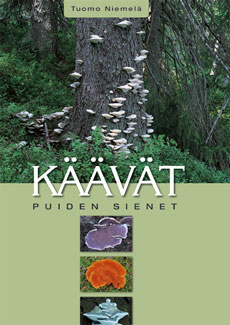Tuomo Niemelä 2005: Käävät – puiden sienet. (Polypores, lignicolous fungi.) Norllinia 13: 1-320. ISSN 0780-3214. ISBN 952-10-2744-4 (sid.), ISBN 952-10-2745-2 (nid.)
Kirja on loppuunmyyty. The book is sold out

Käävät ovat puiden sieniä. Jotkin kääpälajit lahottavat eläviä puita, toiset ovat kaatuneiden runkojen ja muun kuolleen puun asukkeja, ja muutamat elävät mykorrtisasieninä puiden juuristossa. Monet kääpälajit säilyvät vain vanhoissa, luonnontilaisissa metsissä, ja ovat siksi uhanalaisia.
Suomesta tunnetaan 230 kääpälajia, ne esitellään tässä kirjassa.
- Kääpien rakenne, ekologia ja merkitys.Ulkonäkö, isäntäpuut, levinneisyyden pääpiirteet, hienorakenne.Yli 300 loisteliasta värikuvaa.
- Lisäksi esitellään 11 sellaista lajia, jotka tunnetaan Suomen lähialueilta, ja jotka voivat myös löytyä maastamme.
In this identification book of poroid Basidiomycota (polypores), 230 species are reported to be found in Finland. In addition, 11 such species are highlighted which have been found in neighbouring areas, e.g. Estonia and eastern Sweden, and which may occur in Finland. In the introductory sections the morphology of polypores is outlined, and their biology, distributions, economical importance and protection are discussed. New phylogenetic results, whenever available, were adopted in deciding the limits of the genera. Extensive taxonomical work was conducted while preparing the text, and several genera in the book include original species revisions. Standard Finnish names are given to all the species; many of the names are published here for the first time.
Each species is provided with a four-paragraph description: Macromorphology, Hints for identification, Ecology and distribution, and Microscopy. Texts for the Microscopy sections are original, based on studies of Finnish specimens, or for rarer species Nordic or European materials. Spore dimensions are based on measurements from (3–)5–7 or more specimens; 30 spores were measured from each specimen, and the variability, mean spore length (L), mean width (W) and length/width ratio (Q) were calculated. Up to 30 000 spores were measured for the work. Almost all the species are illustrated with colour photographs mostly taken of fresh basidiocarps in the field; the photographed specimens are documented, some of them being holotype materials.
All the genera are provided with entries featuring their characteristics and keys to the species if two or more exist in the study area. A character table to the genera was compiled, based on 20 macroscopic and microscopic characters. The field identification key to the pileate and effused-reflexed species is based on macroscopic and ecological characters. At the end there are an English summary, a list of selected (mostly regional) literature, and index to the species.
